当前位置:
X-MOL 学术
›
Sustain. Energy Fuels
›
论文详情
Our official English website, www.x-mol.net, welcomes your feedback! (Note: you will need to create a separate account there.)
Performance bounds and perspective for hybrid solar photovoltaic/thermal electricity-generation strategies†
Sustainable Energy & Fuels ( IF 5.6 ) Pub Date : 2018-07-18 00:00:00 , DOI: 10.1039/c8se00046h A. Vossier 1, 2, 3 , J. Zeitouny 1, 2, 3, 4, 5 , E. A. Katz 6, 7, 8, 9 , A. Dollet 1, 2, 3 , G. Flamant 1, 2, 3 , J. M. Gordon 6, 7, 8, 9
Sustainable Energy & Fuels ( IF 5.6 ) Pub Date : 2018-07-18 00:00:00 , DOI: 10.1039/c8se00046h A. Vossier 1, 2, 3 , J. Zeitouny 1, 2, 3, 4, 5 , E. A. Katz 6, 7, 8, 9 , A. Dollet 1, 2, 3 , G. Flamant 1, 2, 3 , J. M. Gordon 6, 7, 8, 9
Affiliation

|
Hybrid solar photovoltaic (PV)/thermal power systems offer the possibility of dispatchable, affordable and efficient solar electricity production – the type of transformative innovation needed for solar cell devices to realize high grid penetration. The PV sub-system enjoys high efficiency, and the thermal sub-system can ensure uninterrupted power delivery via backup gas heating and/or multi-hour thermal storage. However, elucidation of the basic performance bounds, and the quantitative perspective required for judging the leading hybrid strategies relative to one another, as well as relative to the existing alternative of autonomous photovoltaic and solar thermal power systems, have remained incomplete. A more thorough and basic evaluation of the performance of the assorted combinations of PV and solar thermal sub-systems over a wider range of possible operating conditions than regarded previously is presented here. This involves analysis of the most fundamental processes limiting system efficiency, tempered by the realities of current and foreseeable PV and thermal technologies. The 3 leading hybrid strategies are: (1) concentrated solar beam radiation irradiating an integrated PV–thermal receiver, with the unique advantage of recuperating PV thermalization losses as heat delivered to the thermal receiver, thereby contributing to driving the turbine, (2) the spectral splitting of concentrated solar beam radiation, with sub-bandgap photons directed to a thermal receiver and the rest to concentrator PV cells, and (3) nominally 1 sun PV cells performing double duty as both a direct converter and as a spectrum-splitting reflector that concentrates sub-bandgap photons onto a thermal receiver. The two figures of merit appraised are: (a) the solar-to-electricity conversion efficiency, and (b) the share between thermal and PV electricity production.
中文翻译:

太阳能光伏/热电混合发电策略的性能界限和前景†
混合太阳能光伏(PV)/火电系统提供了可调度,可负担且高效的太阳能发电的可能性,这是太阳能电池设备实现高电网渗透率所需的转型创新类型。光伏子系统具有很高的效率,而热子系统可确保通过备用气体加热和/或数小时的储热。然而,关于基本性能界限的阐释以及判断领先的混合动力策略彼此之间以及相对于自主光伏和太阳能热发电系统的现有替代方法所需要的定量角度,仍是不完整的。本文介绍了比以前认为的在更广泛的可能工作条件下对光伏和太阳能热子系统的各种组合的性能进行的更彻底和更基本的评估。这涉及对限制系统效率的最基本过程的分析,该过程受当前以及可预见的PV和热技术的现实影响。3种领先的混合策略是:(1)集中太阳束辐射照射集成的PV-热接收器,其独特的优势是可将传递给热接收器的热量恢复成PV的热损失,从而有助于驱动涡轮机;(2)集中的太阳束辐射的光谱分裂,将子带隙光子定向到热接收器,其余部分带到热接收器。集中器PV电池,以及(3)标称1个太阳PV电池,既充当直接转换器又充当将次带隙光子集中到热接收器上的分光反射器,承担着双重职责。评估的两个优值指标是:(a)太阳能转化为电能的效率,以及(b)火力发电量和PV发电量之间的比重。(2)集中的太阳束辐射的光谱分裂,其中子带隙光子定向到热接收器,其余的定向到聚光器PV电池,(3)标称1个太阳PV电池既充当直接转换器又充当双重任务光谱分离反射器,将子带隙光子集中到热接收器上。评估的两个优值指标是:(a)太阳能转化为电能的效率,以及(b)火力发电量和PV发电量之间的比重。(2)集中的太阳束辐射的光谱分裂,其中子带隙光子定向到热接收器,其余的定向到聚光器PV电池,(3)标称1个太阳PV电池既充当直接转换器又充当双重任务光谱分离反射器,将子带隙光子集中到热接收器上。评估的两个优值指标是:(a)太阳能转化为电能的效率,以及(b)火力发电量和PV发电量之间的比重。
更新日期:2018-07-18
中文翻译:

太阳能光伏/热电混合发电策略的性能界限和前景†
混合太阳能光伏(PV)/火电系统提供了可调度,可负担且高效的太阳能发电的可能性,这是太阳能电池设备实现高电网渗透率所需的转型创新类型。光伏子系统具有很高的效率,而热子系统可确保通过备用气体加热和/或数小时的储热。然而,关于基本性能界限的阐释以及判断领先的混合动力策略彼此之间以及相对于自主光伏和太阳能热发电系统的现有替代方法所需要的定量角度,仍是不完整的。本文介绍了比以前认为的在更广泛的可能工作条件下对光伏和太阳能热子系统的各种组合的性能进行的更彻底和更基本的评估。这涉及对限制系统效率的最基本过程的分析,该过程受当前以及可预见的PV和热技术的现实影响。3种领先的混合策略是:(1)集中太阳束辐射照射集成的PV-热接收器,其独特的优势是可将传递给热接收器的热量恢复成PV的热损失,从而有助于驱动涡轮机;(2)集中的太阳束辐射的光谱分裂,将子带隙光子定向到热接收器,其余部分带到热接收器。集中器PV电池,以及(3)标称1个太阳PV电池,既充当直接转换器又充当将次带隙光子集中到热接收器上的分光反射器,承担着双重职责。评估的两个优值指标是:(a)太阳能转化为电能的效率,以及(b)火力发电量和PV发电量之间的比重。(2)集中的太阳束辐射的光谱分裂,其中子带隙光子定向到热接收器,其余的定向到聚光器PV电池,(3)标称1个太阳PV电池既充当直接转换器又充当双重任务光谱分离反射器,将子带隙光子集中到热接收器上。评估的两个优值指标是:(a)太阳能转化为电能的效率,以及(b)火力发电量和PV发电量之间的比重。(2)集中的太阳束辐射的光谱分裂,其中子带隙光子定向到热接收器,其余的定向到聚光器PV电池,(3)标称1个太阳PV电池既充当直接转换器又充当双重任务光谱分离反射器,将子带隙光子集中到热接收器上。评估的两个优值指标是:(a)太阳能转化为电能的效率,以及(b)火力发电量和PV发电量之间的比重。



























 京公网安备 11010802027423号
京公网安备 11010802027423号